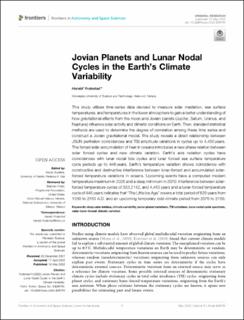| dc.contributor.author | Yndestad, Harald | |
| dc.date.accessioned | 2022-12-05T13:00:03Z | |
| dc.date.available | 2022-12-05T13:00:03Z | |
| dc.date.created | 2022-05-18T10:16:51Z | |
| dc.date.issued | 2022 | |
| dc.identifier.citation | Frontiers in Astronomy and Space Sciences. 2022, 1-19. | en_US |
| dc.identifier.issn | 2296-987X | |
| dc.identifier.uri | https://hdl.handle.net/11250/3035879 | |
| dc.description.abstract | This study utilizes time-series data devised to measure solar irradiation, sea surface temperatures, and temperatures in the lower atmosphere to gain a better understanding of how gravitational effects from the moon and Jovian planets (Jupiter, Saturn, Uranus, and Neptune) influence solar activity and climatic conditions on Earth. Then, standard statistical methods are used to determine the degree of correlation among these time series and construct a Jovian gravitational model. The study reveals a direct relationship between JSUN perihelion coincidences and TSI amplitude variations in cycles up to 4,450 years. The forced solar accumulation of heat in oceans introduces a new phase relation between solar forced cycles and new climate variation. Earth’s axis nutation cycles have coincidences with lunar nodal tide cycles and lunar forced sea surface temperature cycle periods up to 446 years. Earth’s temperature variation shows coincidence with constructive and destructive interference between lunar-forced and accumulated solar-forced temperature variations in oceans. Upcoming events have a computed modern temperature maximum in 2025 and a deep minimum in 2070. Interference between solar-forced temperature cycles of 333,2142, and 4,450 years and a lunar-forced temperature cycle of 445 years indicates that “The Little Ice Age” covers a total period of 820 years from 1330 to 2150 A.D. and an upcoming temporary cold climate period from 2070 to 2150. | en_US |
| dc.language.iso | eng | en_US |
| dc.publisher | Frontiers | en_US |
| dc.rights | Navngivelse 4.0 Internasjonal | * |
| dc.rights.uri | http://creativecommons.org/licenses/by/4.0/deed.no | * |
| dc.title | Jovian Planets and Lunar Nodal Cycles in the Earth’s Climate Variability | en_US |
| dc.title.alternative | Jovian Planets and Lunar Nodal Cycles in the Earth’s Climate Variability | en_US |
| dc.type | Peer reviewed | en_US |
| dc.type | Journal article | en_US |
| dc.description.version | publishedVersion | en_US |
| dc.source.pagenumber | 1-19 | en_US |
| dc.source.journal | Frontiers in Astronomy and Space Sciences | en_US |
| dc.identifier.doi | 10.3389/fspas.2022.839794 | |
| dc.identifier.cristin | 2025063 | |
| cristin.ispublished | true | |
| cristin.fulltext | original | |
| cristin.qualitycode | 1 | |

